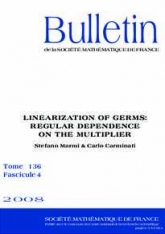Linéarisation des germes : dépendance régulière du multiplicateur
Linearization of germs: regular dependence on the multiplier

- Consulter un extrait
- Année : 2008
- Fascicule : 4
- Tome : 136
- Format : Papier
- Langue de l'ouvrage :
Anglais - Class. Math. : 37F50 ; 37F25
- Pages : 533-564
- DOI : 10.24033/bsmf.2565
On montre que la linéarisation d’un germe d’application holomorphe du type $F_\lambda(z)=\lambda(z+O(z^2))$ a une dépendence $\mathcal{C}^1$-holomorphe du multiplicateur \lambda. Les fonctions $\mathcal{C}^1$-holomorphes sont $\mathcal{C}^1$au sens de Whitney, elles sont définies sur des compacts et elles appartiennent au noyau de l’operateur $\bar\partial$.
La linéarisation est analytique pour $|\lambda|\ne1$ et le cercle $\mathbb{S}^1$ est sa frontière naturelle (due aux résonances, c’est-à-dire les racines de l’unité). Neamoins la linéarisation est encore définie dans la plupart des points de $\mathbb{S}^1$, plus précisement aux points qui se trouvent « assez loin des résonances » et qui correspondent à des conditions arithmétiques adéquates imposées au multiplicateur. Nous construisons une suite croissante d’ensembles compacts qui évitent les résonances et nous démontrons que la linéarisation appartient aux espaces associés aux fonctions $\mathcal{C}^1$-holomorphes. C’est un cas particulier de la théorie des fonctions monogènes uniformes de Borel [2], et les espaces de fonctions correspondants sont quasi-analytiques par chemins [11]. Comme conséquence nous montrons que la linéarisation a un développement asymptotique en $(\lambda − \lambda_0)$ dans tous les points $\lambda_0\in\mathbb{S}^1$ qui verifient la condition de Brjuno. En effet le developpement est du type Gevrey aux points diophantiens.

